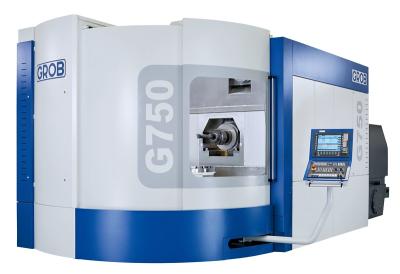
GROB Systems, a global leader in the development of manufacturing systems and machine tools, announces the availability of its new G750 5-axis universal machining center, which offers top notch industrial manufacturing milling for large parts. The G750 provides high productivity, optimized availability, and significant flexibility. It offers a compact design that features optimized access and superior maintainability, with available round-the-clock service.
The G750’s unique machine concept includes a horizontal spindle position that permits the longest possible Z-travel path and optimum chip fall. The arrangement of the three linear axes offers maximum stability by minimizing the distance between the guides and the machining point (TCP). The G750’s tunnel concept allows the largest possible component to be swiveled and machined within the work area without collision – even with extremely long tools. Three linear and two rotary axes permit 5-sided machining, as well as 5-axis simultaneous interpolation, with a swivel range of 230 degrees in the A-axis and 360 degrees in the B-axis.
The G750 is available with a variety of powerful tilting rotary table versions with the latest torque motor technology and optimized dynamics. Users can choose between models with T-slots arranged in parallel (standard) or optional pallet clamping system.
A broad range of spindles are offered, ranging from 6,000 to 30,000(rpm) and 47 to 575 (Nm). The GROB motorized spindle with cross-feed allows complex internal and external contours to be manufactured with controllable tools. It offers convincing system rigidity, high cutting speeds for machining contours, and low tool costs. The GROB chip-in-spindle detection system (SiS) detects tool clamping faults, optimizing the machining process and avoiding damage. Additional single and double disk type tool magazines are available for the G750, providing fast chip-to-chip times, a smaller space requirement and optimized accessibility.
Available automation options include a pallet changer system and customer-specific automation solutions. GROB software solutions are available to optimize and analyze the machine kinematics of the G750 and minimize deviations down to the finest detail.
An extensive range of accessories increases the G750’s flexibility and productivity. Examples include a high-pressure fluid cutting system, decentralized work area mist collecting system, and an oil skimmer that helps keep cutting fluid as clean as possible.
Contact Details
Related Glossary Terms
- cutting fluid
cutting fluid
Liquid used to improve workpiece machinability, enhance tool life, flush out chips and machining debris, and cool the workpiece and tool. Three basic types are: straight oils; soluble oils, which emulsify in water; and synthetic fluids, which are water-based chemical solutions having no oil. See coolant; semisynthetic cutting fluid; soluble-oil cutting fluid; synthetic cutting fluid.
- gang cutting ( milling)
gang cutting ( milling)
Machining with several cutters mounted on a single arbor, generally for simultaneous cutting.
- interpolation
interpolation
Process of generating a sufficient number of positioning commands for the servomotors driving the machine tool so the path of the tool closely approximates the ideal path. See CNC, computer numerical control; NC, numerical control.
- machining center
machining center
CNC machine tool capable of drilling, reaming, tapping, milling and boring. Normally comes with an automatic toolchanger. See automatic toolchanger.
- milling
milling
Machining operation in which metal or other material is removed by applying power to a rotating cutter. In vertical milling, the cutting tool is mounted vertically on the spindle. In horizontal milling, the cutting tool is mounted horizontally, either directly on the spindle or on an arbor. Horizontal milling is further broken down into conventional milling, where the cutter rotates opposite the direction of feed, or “up” into the workpiece; and climb milling, where the cutter rotates in the direction of feed, or “down” into the workpiece. Milling operations include plane or surface milling, endmilling, facemilling, angle milling, form milling and profiling.
- parallel
parallel
Strip or block of precision-ground stock used to elevate a workpiece, while keeping it parallel to the worktable, to prevent cutter/table contact.
